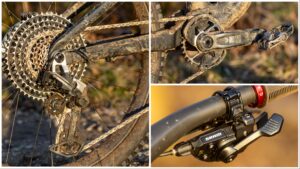DT Swiss F353 fork is so stealth looking, you could easily be forgiven for assuming some kind of hidden auto-damping computer lurks inside!
DT Swiss F535 One suspension fork review
DT Swiss F535 fork is so stealth looking, you could easily be forgiven for assuming some kind of hidden auto-damping computer lurks inside!
Read more: Best mountain bike forks – get the best suspension fork for your bike
In fact, regular damping adjustment dials are hidden under protective ‘blanking’ covers on the top of the crown for a very clean look.

Adjustment parameters are pretty standard – low speed rebound and compression and three-way adjustable support platform, dialled in by a quick spin of a Torx 10 key that’s handily hidden inside the axle’s QR lever blade. The F535 uses 35mm stanchions and a boxy crown and brace, which is now up front, rather than trailing as on previous DT Swiss offerings. The fork only comes in the longer 51mm offset, which makes the steering feel a bit light and twitchy on steep tracks compared to the other forks on test with their shorter rakes.

DT Swiss’s damping uses an unusual, position-sensitive, compression design with a floating internal piston that tells the fork to add progressively more damping as it moves deeper into the travel for extra support. DT Swiss only recommended an (unusually long) annual service interval, so while it’s a bit portly, reliability should be sorted thanks to all metal small parts, oversized bushings and Swedish SKF seals.
The air spring is a self-balancing design that can be made more progressive by adding volume spacers, and has the added twist of an extra coil spring to smooth out the initial friction inherent in air springs. This ‘negative’ coil works in the first 8mm of stroke, and is extremely effective in killing buzz from vibrations and small ripples.

The F535 has a super-smooth, almost hoverboard feel over chatter and small stones and is a great option for a trail rider looking for a very isolated, comfortable, coil-like feel in the beginning stroke. If you push harder or are hunting race wins, DT Swiss’ fork might be less optimised.
Over repeated braking bumps and deeper hits, the F535 is less stable, and there’s also less support once the fork moves off the coil spring (at air pressures that allow you to achieve full travel). Conversely, a lot of force is needed to drive it right through, which is likely a consequence of compression damping increasing towards bottom out, due to the position-sensitive design.

If you’re heavier or more aggressive, the F535 can feel a little flexy and twangy landing big jumps and hitting repeated drops – especially when weight is pitched onto the front tyre twisting down steeps. In this sense, it’s the least solid feeling on test, despite also being one of the heaviest forks.
DT Swiss’ F535 is arguably the smoothest on test, especially on the kind of trail centre surfaces a lot of people actually ride, but once bumps get fist size and fight back, the damping feels a bit firm and the chassis a bit soft, impacting on stability and control. Messing about removing the blanking covers to tune set-up also got tedious quite quickly.
















